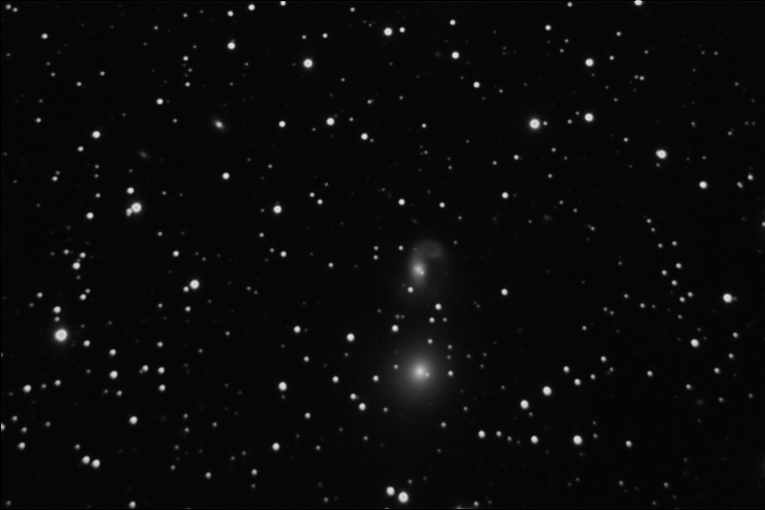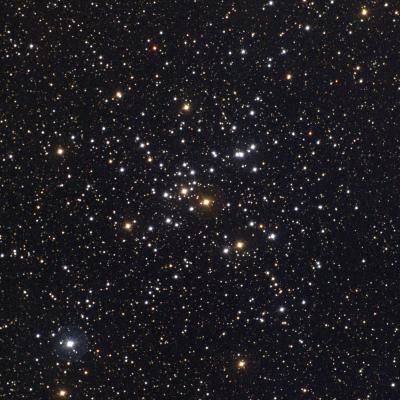STARLOG
TWO IN THE VIEW
FEBRUARY 16, 2017
| Observer: |
Tom Campbell |
| Location: |
College Station, Texas (Long: 96°17'W Lat: 30°37'N) |
| Telescope: |
Zhumell 12" f/5 Dobsonian |
| Eyepieces: |
Explore Scientific 18mm (83x)
Explore Scientific 11mm (136x) |
| Lenses: |
Celestron Luminos Barlow (2.5x) |
| Weather: |
The sky was partly cloudy. Temperature was in the mid 50s (F), with a slight breeze, turning colder as evening progressed. |
OBSERVING SUMMARY:
CANIS MAJOR: ε CMa, η CMa, M41
GEMINI: NGC 2274, NGC 2275
Lately, I've been noticing some problem with my telescope losing collimation, Especially the secondary mirror. As many people know, a while back ago I outfitted my Dobsonian base with a pair of wheels so that I could roll the telescope into my back yard without breaking my back. So it's not really surprising that the mirrors get a little bit out of alignment every time I hit a bump in the yard. But it seemed that it was even losing collimation during the course of an observing session, when the telescope is relatively still.
Normally, I collimate my telescope by having it pointed almost horizontally. This has a couple of advantages.
First, my secondary mirror has phillips-head adjustment screws, so if I drop the screwdriver while adjusting them, it won't drop down and hit the mirror. At worst, it will slide down the telescope tube slowly and give me time to retrieve it before it even reaches the mirror end.
Secondly, the horizontal position allows me to easily adjust the primary mirror, which is at the bottom of the telescope. I can look at the laser collimator in the focuser while adjusting the primary mirror screws until everything is aligned.
However, I noticed that whenever I started tilting my telescope upwards, the laser beam in the collimator would start to drift away from center, meaning the telescope was no longer perfectly aligned.
So I did some research online and found a few things to look for. I noticed that a couple of the screws for my secondary mirror vane were a bit loose. I tightened those down. I also made a set of thumbscrews (using a cap head screw and a couple of nuts) to adjust the secondary mirror with in the future so I didn't have to use a screwdriver.
These changes did seem to help some. As I collimated tonight, I noticed that the alignment did adjust a bit when moving the telescope from horizontal to vertical, but only very slightly. Not enough to make much difference during the course of an evening. If I decide to stop this slippage altogether, I will probably have to invest in some stronger springs for the primary mirror. To confirm my collimation, I performed a star test on Sirius with my barlowed 11mm eyepiece (341X). There was some air turbulence, but ignoring that, the diffraction pattern was textbook perfect.
But there's only one way to find out. Leaving the barlowed 11mm in my telescope, I swung over to the Trapezium in the middle of Orion's Nebula. Four bright points of light and two fainter pinpricks. All six stars!
Time to get some observing in. Unfortunately, I wasn't expecting the skies to be all that great tonight, so I didn't have an observing plan made up. There were some clouds in the sky, but for the most part, they were in the light-polluted sections of sky and weren't really interfering with the view.
Gemini was high overhead. I remembered I still had a galaxy or two from the Herschel list that I needed to observe there, so I took aim.
| NGC 2274/2275 |
Gemini |
Galaxies |
8:45pm CST |
 |
These are very faint galaxies from my backyard. I can barely detect the cores. Both are of a similar magnitude, but 2274 appears perhaps a bit brighter. With direct vision, they almost disappear. With averted vision, I can barely detect a bit of fuzziness surrounding the pinpoint central cores. |
| |
I was excited. But Gemini was too high up in the sky, making it difficult to aim my telescope properly. I looked for something a little lower in the sky. Canis Major was placed well and I had a few double stars I wanted to observe there, but some clouds were starting to drift in front of it. I decided to go in for a bit to let the clouds pass by, while I printed out an observing list for the Greater Dog.
| ε CMa (Adhara) |
Canis Major |
Double Star |
9:30pm CST |
This is a very wide double. It is the back foot of the dog and the companion must be one of his toes. The primary is very bright and bluish-white. The secondary is pale yellow, about 2-3 magnitudes fainter. Even at low power (50x), it is widely separated and would make a nice double for a small telescope. I observed this one before for my Astronomical League award, but somehow I lost my notes for it. It was due to be seen again, anyway. |
| |
| η CMa (Aludra) |
Canis Major |
Optical Double |
9:35pm CST |
This is the tail of the dog. This optical double looks similar to Adhara, but the two stars appear about twice as close. Aludra appears white and the fainter star appears to be yellow white. |
| |
Lepus was out of the clouds again now, so I aimed there. I tried for NGC 1823, but by this time, it had started drifting over into a severe patch of light pollution and I really had no chance of seeing it. A pity, because I knew my telescope was finely tuned.
It was getting colder and the winds were picking up. I started out this evening wearing a light jacket, and now I was wearing a coat and hood, and wishing for gloves. I decided to look at one more favorite before calling it a night.
| M 41 |
Canis Major |
Open Cluster |
10:25pm CST |
 |
The best view was with my 18mm eyepiece (83X). I tried using 50X and 60X on this one and the cluster was a nice size in the eyepiece, but with the 18mm, another whole level of detail becomes visible. The cluster makes a rosette pattern. There is almost a complete circle of somewhat faint stars in the center. A couple of the brighter stars in the cluster appear yellow-orange. |
| |
Time to pack it in. I got over some of my collimation woes tonight and managed to catch a few new objects, even without a real observing plan, so I'd call that a success. It was great to be out under the stars again.

